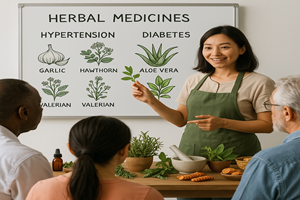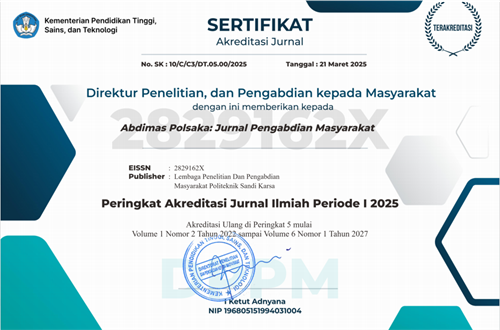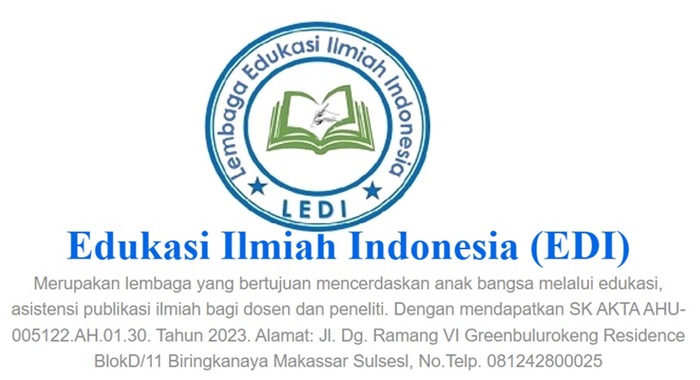Education and training on the use of herbal medicines as complementary therapies for hypertension and diabetes
DOI:
https://doi.org/10.35816/abdimaspolsaka.v4i2.103Keywords:
Complementary therapy, Diabetes mellitus, Health education, Herbal medicine, HypertensionAbstract
Hypertension and diabetes mellitus are two non-communicable diseases with increasing prevalence in Indonesia, including in rural areas such as Kamulyan Village, Bantarsari Subdistrict, Cilacap Regency. Both conditions require long-term management using a holistic approach, including integrating complementary therapies based on medicinal plants. Unfortunately, community understanding of herbal medicine's proper and safe use remains limited. This community service program aims to improve the knowledge and skills of residents in Kamulyan Village in utilizing herbal remedies as complementary therapy for hypertension and diabetes mellitus. The implementation methods included health education sessions on the introduction of hypertension and diabetes, as well as education on various types of local medicinal plants that are empirically proven to help control blood pressure and blood glucose levels, such as bay leaves (Syzygium polyanthum), bitter leaf (Andrographis paniculata), Phyllanthus niruri, cat’s whiskers (Orthosiphon aristatus), and Tinospora crispa. In addition, practical training was conducted on preparing and processing these herbs into simple formulations that can be used independently at home, such as herbal teas, decoctions, and dried capsules. The activity was attended by 50 participants: health cadres, elderly residents, and patients with hypertension and diabetes. Through pre-test and post-test assessments, participants’ knowledge and skills related to herbal medicine usage were significantly increased. Participants also demonstrated high enthusiasm for cultivating and utilizing family medicinal plants (TOGA) around their homes. This initiative is expected to be the first step toward community self-reliance in maintaining health naturally and sustainably. In the future, further assistance and cross-sector collaboration are needed to develop the scientific, safe, and effective use of herbal medicine at the community level.
Downloads
References
A. P. Addienisahna, “Design of ‘Inclusive Village’ By Optimizing Training Facilities as a Disability-Inclusive Innovation in Pucung Tourism Village, Kismantoro, Wonogiri.” Universitas Islam Indonesia, 2024.
T. Dzinamarira et al., “Advancing Sustainable HIV Services Through Integration in Primary Healthcare in Sub-Saharan Africa: A Perspective on Practical Recommendations,” Healthcare, vol. 13, no. 2, p. 192, Jan. 2025, doi: https://dx.doi.org/10.3390/healthcare13020192.
K. Mansoor et al., “Awareness and attitude towards complementary and alternative medicine among pharmacy- and non-pharmacy- undergraduate students: A cross-sectional study from Jordan,” Curr. Pharm. Teach. Learn., vol. 17, no. 5, p. 102297, 2025, doi: https://doi.org/10.1016/j.cptl.2025.102297.
M. Koleti, C. Dokyi, J. Kim, and L. M. Belalcazar, “A Scoping Review of Self-Medication in Exogenous Cushing Syndrome: The Role of Social Determinants of Health in the Case Report Literature,” Endocr. Pract., 2025, doi: https://doi.org/10.1016/j.eprac.2025.06.024.
Y.-T. Chen et al., “The safety and efficacy of Chinese herbal medicine for pneumonia prevention in high-risk elder residents in the nursing home: A randomized, double-blind clinical trial,” J. Ethnopharmacol., vol. 318, p. 117017, 2024, doi: https://doi.org/10.1016/j.jep.2023.117017.
Z. Kılıç and R. Çırpan, “Effect of clinical control and symptom severity on attitudes towards holistic complementary alternative medicine in individuals with chronic obstructive pulmonary disease: A cross-sectional study,” Eur. J. Integr. Med., vol. 72, p. 102415, 2024, doi: https://doi.org/10.1016/j.eujim.2024.102415.
R. Klickman, “Integrative Veterinary Hospice and Palliative Care,” Vet. Clin. North Am. Small Anim. Pract., 2025, doi: https://doi.org/10.1016/j.cvsm.2025.06.010.
A. Loh, H. Li, W. C. Lam, Y. Y. Tjioe, W. Fong, and L. L. D. Zhong, “Establishing expert consensus on Chinese herbal medicine for rheumatoid arthritis management in Singapore,” J. Tradit. Chinese Med. Sci., vol. 12, no. 3, pp. 319–327, 2025, doi: https://doi.org/10.1016/j.jtcms.2025.06.004.
O. Amuwo, “A mosaic of medicine: Acquainting pharmacy education with the rich tapestry of African-descent immigrant cultures,” Curr. Pharm. Teach. Learn., vol. 17, no. 4, p. 102296, 2025, doi: https://doi.org/10.1016/j.cptl.2025.102296.
M. Assi, S. Nasser, R. Almoussawi, F. Hamed, R. Boukhary, and J. Wattar, “A Cross-sectional Study on Utilization of Herbal Medications for Anxiety in the Lebanese Population: Usage Patterns and Implications for Harmonizing Mental Health,” Open Public Health J., vol. 17, 2024, doi: https://doi.org/10.2174/0118749445342434241021111304.
Z. Zheng et al., “Comorbidity profiles and treatment patterns of osteoarthritis patients in Beijing: A cross-sectional study based on community medical records,” Chinese Gen. Pract. J., vol. 2, no. 2, p. 100061, 2025, doi: https://doi.org/10.1016/j.cgpj.2025.100061.
M. Assi, R. AlMoussawi, R. Boukhary, S. Nasser, J. Wattar, and M. Akel, “Examination of Herbal-drug Interactions: Implications for Patient Safety and Healthcare Practice in Lebanon: A Cross-sectional Study,” Open Public Health J., vol. 17, 2024, doi: https://doi.org/10.2174/0118749445336623241009061157

Additional Files
Published
How to Cite
Issue
Section
License
Copyright (c) 2025 Muh Agus Salim, Anjali Nurvitasari, Emy Suryani, Aisyah Fatimatul Khoeriyah, Lailiya Ramadanti, Feny Izzatul Latifah, Wiku Anjen Subekti

This work is licensed under a Creative Commons Attribution 4.0 International License.




















